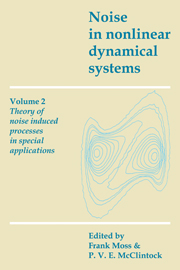Book contents
- Frontmatter
- Contents
- List of contributors
- Preface
- Introduction to Volume 2
- 1 Stochastic processes in quantum mechanical settings
- 2 Self-diffusion in non-Markovian condensed-matter systems
- 3 Escape from the underdamped potential well
- 4 Effect of noise on discrete dynamical systems with multiple attractors
- 5 Discrete dynamics perturbed by weak noise
- 6 Bifurcation behavior under modulated control parameters
- 7 Period doubling bifurcations: what good are they?
- 8 Noise-induced transitions
- 9 Mechanisms for noise-induced transitions in chemical systems
- 10 State selection dynamics in symmetry-breaking transitions
- 11 Noise in a ring-laser gyroscope
- 12 Control of noise by noise and applications to optical systems
- 13 Transition probabilities and spectral density of fluctuations of noise driven bistable systems
- Index
8 - Noise-induced transitions
Published online by Cambridge University Press: 05 January 2012
- Frontmatter
- Contents
- List of contributors
- Preface
- Introduction to Volume 2
- 1 Stochastic processes in quantum mechanical settings
- 2 Self-diffusion in non-Markovian condensed-matter systems
- 3 Escape from the underdamped potential well
- 4 Effect of noise on discrete dynamical systems with multiple attractors
- 5 Discrete dynamics perturbed by weak noise
- 6 Bifurcation behavior under modulated control parameters
- 7 Period doubling bifurcations: what good are they?
- 8 Noise-induced transitions
- 9 Mechanisms for noise-induced transitions in chemical systems
- 10 State selection dynamics in symmetry-breaking transitions
- 11 Noise in a ring-laser gyroscope
- 12 Control of noise by noise and applications to optical systems
- 13 Transition probabilities and spectral density of fluctuations of noise driven bistable systems
- Index
Summary
Introduction
All macroscopic systems are subject to irregular perturbations that cannot be modelled in a deterministic description. Following common usage, we shall call these perturbations ‘noise’. These may be ‘internal fluctuations’, due to the complex interaction of parts of a composite system, or they may be ‘external noise’, due to an irregular influence imposed on the system from the environment to which it is coupled. In this chapter we shall be interested particularly in the latter type of fluctuations and their effects on the macroscopic behavior of open nonlinear systems. It is well known now that nonlinear systems, such as the laser (Haken, 1978), the Couette system (Di Prima and Swinney, 1981), and the Belousov–Zhabotinskii reaction (Field and Burger, 1985), can display a rich variety of transition phenomena leading to temporal (and spatial) structuring: bistability, limit cycle oscillations, period doubling behavior, aperiodic behavior, etc. These transitions are due to the nonequilibrium constraints imposed by the environment on the system. It is under nonequilibrium conditions that the intrinsic nonlinearities of the system come fully into play; at and near equilibrium the behavior of these macroscopic systems can be well described by linear laws.
In light of this fact, it is particularly important to take into account that environments of open systems, and thus the external constraints imposed on the system, fluctuate in general more or less strongly. Rapid random fluctuations are always present in natural systems and their amplitude is not necessarily small, contrary to laboratory systems.
Information
- Type
- Chapter
- Information
- Noise in Nonlinear Dynamical Systems , pp. 179 - 208Publisher: Cambridge University PressPrint publication year: 1989
Accessibility standard: Unknown
Why this information is here
This section outlines the accessibility features of this content - including support for screen readers, full keyboard navigation and high-contrast display options. This may not be relevant for you.Accessibility Information
- 25
- Cited by
